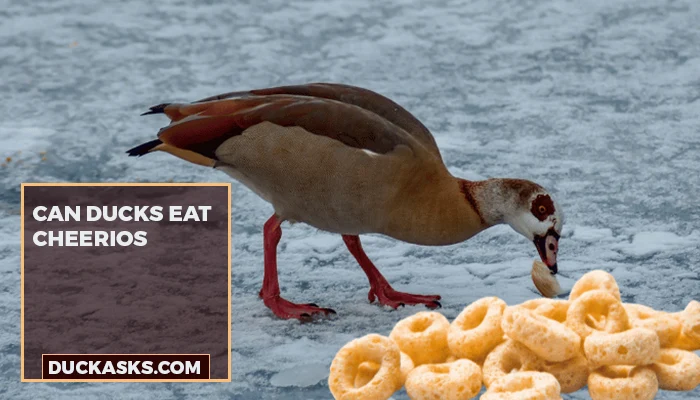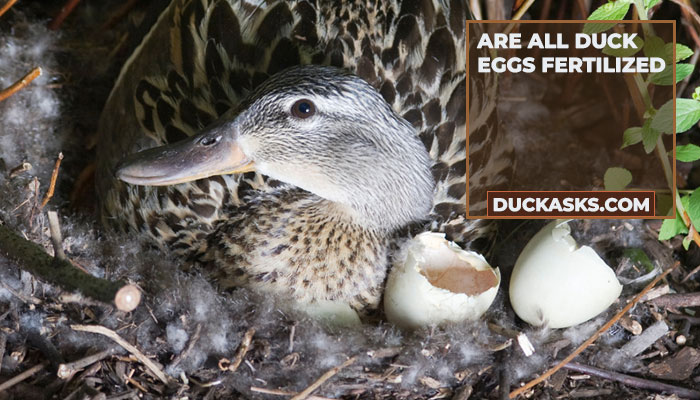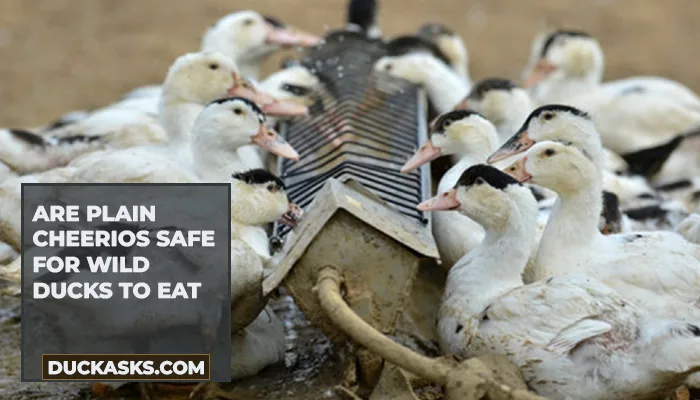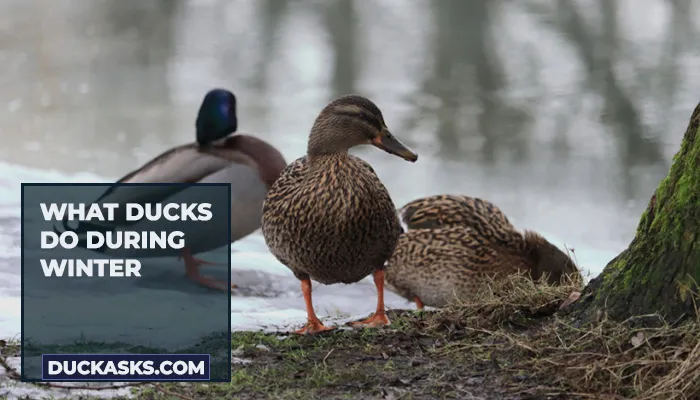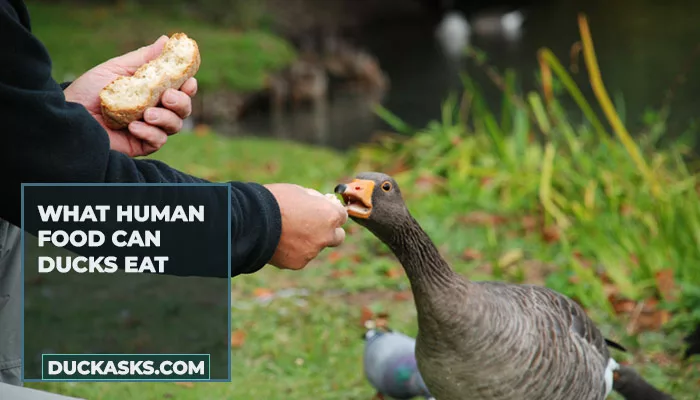Do Pet Ducks Fly Away?
Ducks try to fly 60 days into birth, and it takes a year to master it. For the last seven years, I have been petting ducks; even though some can fly, they never tried. The duck breed, weight, size, and the environment you’ve put it in play a role in flying.
Pet ducks can indeed fly. But if they are comfortable in-home conditions, they won’t. Some pet ducks fly yet come back at the same route.
Being domestic, others might wander in the wild until they get lost. Most of the time, they stay in familiar places.
Check out the whole article to know which duck breeds fly, if pet ducks need training and the risks associated with flying away.
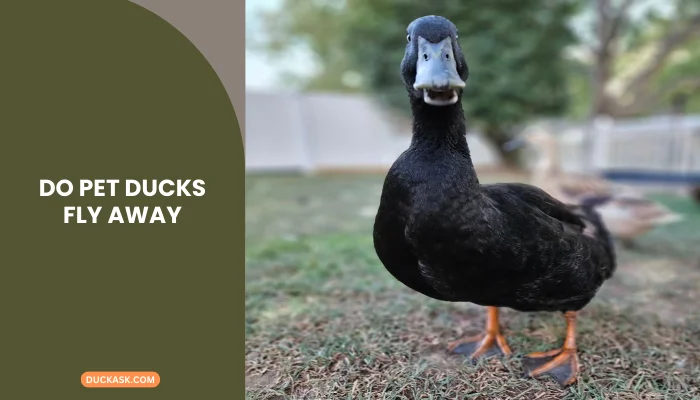
Read more about ducks behavior:
Can All Domestic Ducks Fly?
Domestic ducks are bred in multiple conditions, including size, egg-laying capacity, or color. As a result of the long process, most pet ducks lose their natural ability to fly.
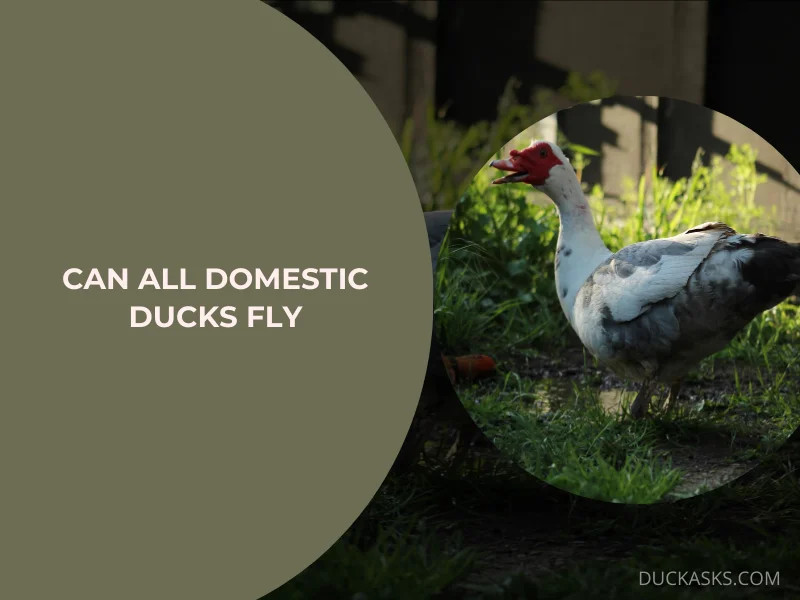
For example, Pekin ducks or such kinds evolve in domestic nature contrary to their wild counterparts. Body proportion also determines if they can fly. Shorter wings usually decrease the chances of flying.
The evolved physical characteristic makes it harder for pet ducks to lift wings and create a mechanism to fly.
For example, my two Silver Appleyards can make short hops and try to flatter but cannot fly. Pets can fly a short distance, but most can’t fly high distances like wild ducks.
If your pet is raised from birth or at a young age, it may lose their ability to fly. The reason is simple. Within domestic care, they don’t develop wing muscles and don’t need the skills to fly away.
Also, pet ducks often don’t practice flying exercises contrary to wild ones. But my Muscovy ducks can fly even though I’ve pet them for a long time. And the healthy conditions I keep them in have prevented their departure.
Will Domesticated Ducks Fly South for the Winter?
Flying south for the winter is a migratory behavior. They are primarily seen in wild ducks due to genetic, environmental, and hormonal changes.

Pet ducks don’t have the same migratory instinct as wild ducks. Again, they are brought up in a controlled and specific environment, and the atmosphere is catered to their need.
When winter arrives and temperature changes, it reduces the availability of food. For survival, wild ducks change location to south, and it’s encoded in duck genes.
On the contrary, pet ducks are conditioned for specific needs or show purpose. They are kept in environments that meet their changing needs. So, there’s no need for survival instinct. Domestication alters pet ducks’ psychology and behavior.
Frequently, pets are kept safe from harsh environments, and human caregivers give proper care. So, it’s less likely they’ll fly away to the south.
Can Pet Ducks Fly Away If They Are Not Properly Trained?
As much as charming companions pet ducks are, there’s always a fear that they’ll fly away. I’ve mentioned before that domestic ducks have reduced flying abilities due to living in conditioned habitats.
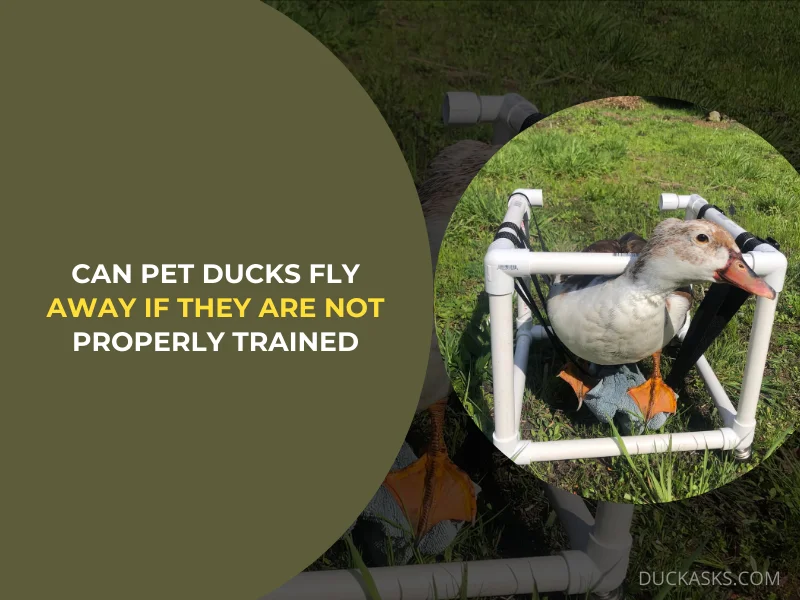
Does training pet ducks create any difference?
Of course, it does. In my early years of petting ducks, I had less experience and couldn’t train my ducks properly.
They could fly, but the flying could have been more short-lived and clumsy and took them nearby. However, I trained them, and gradually, they developed proper flying techniques.
But it also gave them skills to fly. The ducks were conditioned in human care, so they stayed put even after adequate training.
So, the question shouldn’t be if they fly away if ducks are trained. Instead, it depends on whether you care for the breeds in an enclosed environment with proper nutrients.
A special note is that ducks usually lose their migratory instincts after appropriate training. So, there’s a fair chance they won’t leave or fly away after training.
Are There Any Signs or Behaviors that Indicate a Pet Duck Is Likely to Fly Away?
You must observe your ducks to figure it out. Not all ducks will show the same behavior before flying away. But my years of experience have told me there are always some common signs.
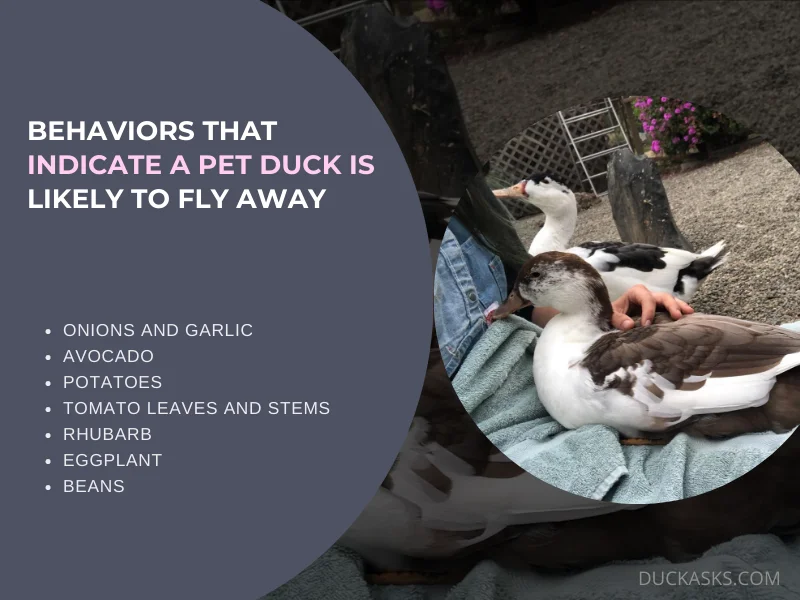
Frequent Flapping
A prominent sign is that the duck shows restlessness, and as a result, it frequently flaps. Before taking off, ducks instinctively flap their wings.
Perching
If your ducks spend time perching on fences or branches, they might prepare for flying. Also, perching on high objects means they’re searching for an escape path.
Wild Ducks
Sometimes, the sight of wild ducks can intrigue the instinct in pets. This might sound weird, but there’s a high probability that pet ducks get intrigued by seeing wild ones flying in the sky.
Anxious
Ducks can be anxious due to unfamiliar animals, routine changes, or loud noises. It’s hard to detect if a duck is anxious.
However, it’s wise to keep an eye on your ducks whenever there’s harsh weather or change in the domestic environment.
Exploration
Ducks will naturally squeeze through gaps and check out different routes. But, if pet ducks repeatedly explore other boundaries or display any exploration behavior, that’s a sign.
Short Flights
Even if the ducks fly low and short, keep an eye open. These flights will lead them near, but it’s often the indicator of flying.
Isolation
Just like every other animal, ducks are social. An isolated or lonely duck shows high signs of flying away. So, it’s better to provide them with companionship and mating options.
How Far Can Pet Ducks Typically Fly?
Pet ducks’ flying distance is short-lived and safe to say limited. At max, ducks can fly up to 300 feet. However, wild ducks can go above 10,000 feet in the sky.
At per distance, general pet ducks, despite the breed, will fly 100 yards at a time. The flights are at lower altitudes than linear journeys.
Pekins cannot fly due to weight, but Mallards can go 100 miles per hour. Lighter ducks have a higher probability of passing far. But most domestic ducks lose their ability to fly, so they can’t fly much higher than their wild counterpart.
Are There Any Risks Associated with Allowing Pet Ducks to Fly?
Yes, there are quite many. Pets who fly around urban or even suburban areas can face many problems.
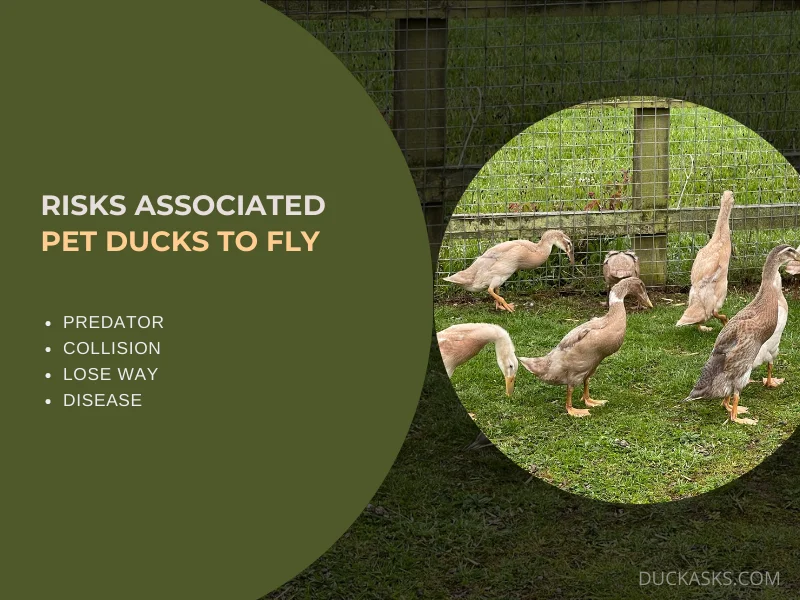
Predator
Dogs, cats, and even larger birds can hunt pet ducks. Usually, in a domestic environment, pet ducks are safe from such predators.
So, flying a bit far can make them easy targets. Also, being unable to escape a hostile environment properly can lead to death.
Collision
Your pets might collide with buildings, vehicles, or fences. From my experience, these cause severe injuries or even fatalities. However, drinking polluted water or food can lead to total health damage.
Lose Way
A common risk is that the duck can lose its way home. Often, new flyers lose route and struggle way back. This can cause stress and lead to predators.
Disease
If a duck contacts wild waterfowl, it can likely carry diseases back home.
What Domestic Breeds Can’t Fly?
| Breed | Reason not to fly |
|---|---|
| Pekin | Heavy and large round body shape |
| Rouen | Rouen Looks like Mallards but has a heavy body weight. Suitable for swimming and waddling. |
| Khaki Campbell | Active yet limited flight due to body structure |
| Aylesbury | Plump and large body size |
| Indian Runner | Slender build and upright posture |
| Swedish | Like Pekin, they’ve heavy bodies |
| Buff | Heavy body weight |
| Cayuga | Iridescent dark plumage prevents flying |
How Do I Keep My Pet Duck from Flying Away?
Ducks are meant for flying, but some careful measures can help prevent this. Even if the pet ducks have reduced flying skills, taking measurements is always safe.
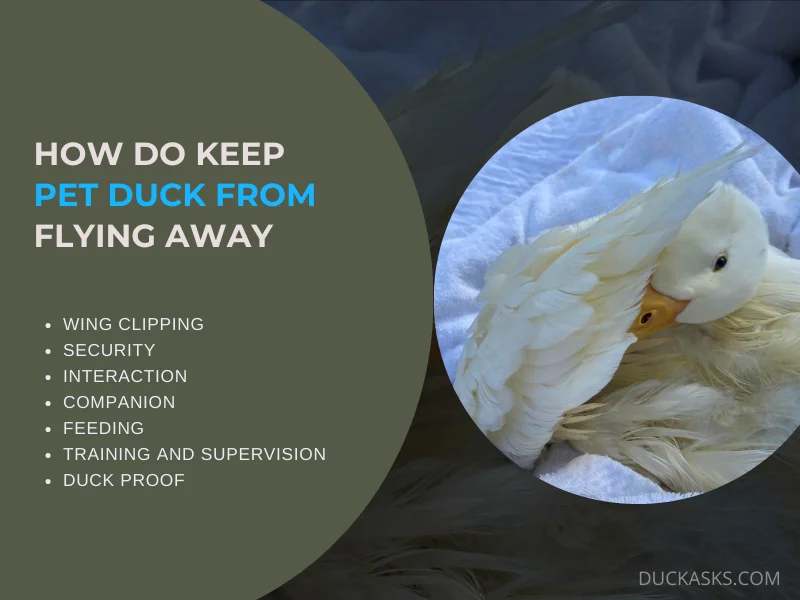
Wing Clipping
The most effective way to prevent your pet from flying is wing clipping. You have to trim strands of prime flight feathers on each wing. A veterinarian or experienced should do this job to avoid harming the ducks.
Security
A well-fenced and secure enclosure limits the chances of flying. Always double-check that there are no gaps so they can slip away. The ideal length should be high to prevent hopping and low to squeeze under the fence.
Interaction
It might sound weird, but spending time with pets and creating a bond does help for the first years of my petting journey; it took me time. But after bonding with my pet ducks, they never seem to fly away.
Companion
Provide the duck’s company with other ducks. It reduces their desire to fly away to find a partner.
Feeding
A primary reason ducks fly away is to find food. Well-fed and healthy ducks will be less likely to fly away. Also, keeping them in a safe, enriched environment and providing suitable shelter and water prevents it.
Training and Supervision
Train the ducks to recall commands. You can practice calling them and reward them if they respond. When outside, always supervise them to prevent encountering danger. In case of injury and illness, take them to vet checkups.
Duck Proof
Just like parents baby-proof their houses, make your estate duck-proof. Remove any hazards or potential harm. For example, cut off toxic plants.
Conclusion
So, do pet ducks fly away? No, they don’t. But an important thing to remember is that you could be doing everything right, yet your pet duck can fly away.
In most cases, domestic ducks don’t fly away with proper care because of their reduced flying capabilities.
If this article helped you, then don’t forget to share it. For more pet-related information, check our Facebook, Pinterest, and Twitter.
References
- https://www.vet.cornell.edu/animal-health-diagnostic-center/programs/duck-research-lab/housing-and-management
- https://opensanctuary.org/things-that-are-toxic-to-ducks/
Image Credit
- Facebook.com/ducks_of_providence
- Facebook.com/EmBell
- Facebook.com/ducks_of_providence
- Facebook.com/EmBell
- Facebook.com/JoshuaChernov
- Facebook.com/DarlaJean

